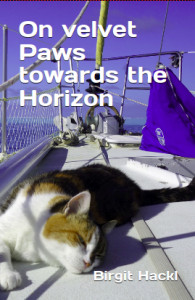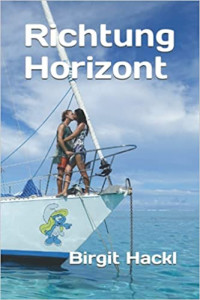We added a small cruising guide about Rurutu (Austral Islands) to our blog, click here to read it.
2018
30
Oct
2018
29
Oct
Indoor program
There’s a front moving by just north of us and we get grey, rainy and very windy weather here. The wind’s howling over the montain and gusts up to 40 knots push Pitufa from one side to the other. Fortunately the sea’s are (still??) rather calm, so we’re having productive indoor-project days.
I got the jewellery workshop out, Christian’s working on the computer and Leeloo is concentrating on growing a thick winterfur. You’d think that a European cat might follow the European seasons in fur-thickness, but watching Leeloo we see that she grows fur according to changes in the temperature and adjusts surprisingly quickly. At the moment she looks as fluffy as a polar-rabbit ![]()
2018
28
Oct
Article about Pitufa’s Atlantic crossing
There is a new article in the current issue (Nov./Dec.) of Ocean7 as well as in the November issue of All at Sea Caribbean. It’s about our Atlantic crossing in 2011/12 and what we think about the ARC.
 Birgit Hackl, Christian Feldbauer: Why we chose not to join an organized rally, All At Sea Caribbean, November 2018, p. 36–38. Free download from allatsea.net.
Birgit Hackl, Christian Feldbauer: Why we chose not to join an organized rally, All At Sea Caribbean, November 2018, p. 36–38. Free download from allatsea.net.

Birgit Hackl, Christian Feldbauer: Gemeinsam — oder doch lieber einsam?, OCEAN7 6 (Nov./Dez.) 2018, p. 52–54
2018
27
Oct
Anchorage on the western side of Rurutu
Yesterday was a busy day in the harbour, because the supply ship arrived. It anchored outside and barges were taking containers in and out all day long. Even though the harbour is fairly new, apparently it was constructed before the freighter company got a new vessel for the Austral Islands which happens to be slightly too big for the harbour… The wind was easterly and it got quite bouncy already. With the forecast predicting stronger northeasterlies (that would bring waves straight into the harbour) we left this morning and sailed around the island to the Bay of Avera on the western side.
We found a sandy spot in 14 m just outside the small-boat pass and are anchored quite nicely. Fortunately the southwesterly swell has gone down–last week the bay looked like a witches’ cauldron with 3 m swell breaking and we couldn’t imagine any boat anchoring here…
2018
25
Oct
Pics from Rarotonga
And here’s the next delayed one:

Rarotonga 2018
Rarotonga was the last stop of our tour through the Cook Islands. We were busy with shopping, provisioning, and hiking and enjoyed 10 pleasant days despite the bouncy, dirty and expensive harbor (Sep./Oct. 2018).
(20 photos)
2018
25
Oct
Hiking on Rurutu
The more we see of Rurutu, the more we fall in love with it. We’ve had a few sunny days and used them to explore all around the island. All along the shores we’ve found white beaches with rugged cliffs behind them. There are lots of caves, but no signs to lead tourists there (the locals know where they are anyway, so why bother with signs?) and we only have a rather sketchy map. We have found most of them anyway and stumbling over a cathedral-like grotto hidden in the forest or the cliffs we feel like real discoverers ![]()
The interior of the island is criss-crossed with trails and dirt tracks and you can spend days walking along the ridges and up the peaks. The three highest peaks lie conveniently along one caldera and we climbed them within 2 hours (they are all between 360 and 390 m high), but then we got lost for another 3 hours on the way down–many trails but no signs are a perfect recipe for adventurous hikes ![]()
First we planned to rent a car, but hitch-hiking is so easy here that we didn’t bother getting our own vehicle in the end. By now everyone on the island seems to know that we’re the ‘sailboatpeople’ and they take us directly to the dock without even asking. Even the gendarmerie car gave us a ride once ![]()
2018
23
Oct
Photos of Aitutaki
At the moment our galleries are quite delayed because we are either at remote places without any Internet or busy exploring and taking new pictures ![]()
Here a few snapshots from Aitutaki in the Southern Cook Islands.

Aitutaki
In September 2018 we spent 10 rolly days anchored on the outer reef of Aitutaki (Southern Cook Islands). We found lots of tourists and not many sights or things to do...
(24 photos)
2018
20
Oct
Beautiful Rurutu
We had little info about Rurutu before we got here, but the island is a pleasant surprise for us. In the Lonely Planet Rurutu is described as a raised atoll, but then it should be just a flat plateau surrounded by coral cliffs like Niue, instead it has cliffs divided by flat coastal regions and high mountains inland, so we think that it must have been a lagoon with volcanic islands and a fringing reef before it was raised by tectonic movements.
The road around the island is 36 km long and it’s dotted with look-outs from steep cliffs and caves. So far we’ve seen three of those caves that were once coral and are now covered in stalactites and stalagmites. There is just very little tourism on Rurutu so the sights have no signs, but friendly locals have directed us there. We’re only the third boat(!) here this year, so people are genuinely interested and hospitable. Hitching rides we’ve found that every car stops for a raised thumb, so today we hitchhiked to the southern end of the island where we found endless white beaches with a thundering 3 m swell breaking spectacularly and makatea cliffs just next to volcanic black rocks.
Rurutu has a surprisingly well developed infrastructure, there are well-stocked supermarkets, a bank with an ATM(!), a petrol station, a hospital and a daily veg and fruit market just next to the little harbour where we are located. The harbour itself is well protected (even though it’s been blowing from the southeast since we got here there are hardly any waves in here) and we share it only with a few small local boats.
If it wasn’t for the weather we’d move in here ![]() . Unfortunately the Australs are very unlucky weatherwise: in winter it gets seriously cold and the rest of the year the convergence zone usually sits somewhere between Samoa and here and lows and troughs travel along that zone. Since we’ve got here we’ve only had 2 sunny days, the rest of the time it’s been rainy, grey and rather chilly (18 degrees at night, low 20s during the day).
. Unfortunately the Australs are very unlucky weatherwise: in winter it gets seriously cold and the rest of the year the convergence zone usually sits somewhere between Samoa and here and lows and troughs travel along that zone. Since we’ve got here we’ve only had 2 sunny days, the rest of the time it’s been rainy, grey and rather chilly (18 degrees at night, low 20s during the day).
2018
18
Oct
Touring around the Austral Islands
After an excursion through the Cook Islands, Pitufa is back in French Polynesia! We are currently in the ‘Archipel des Australes’ and hop from island to island, starting with Maria in the Northwest and finishing with Rapa Iti in the Southeast.
2018
16
Oct
Time for a new generation?
When we bought Pitufa 10 years ago, she was equipped with navigation instruments by Robertson/Simrad which were already 10 years old then. We are still using these instruments, despite their growing need for life-sustaining measures. Read more »
2018
15
Oct
Kissy-kissy country
We have just anchored in the little harbour of Rurutu, which is a big island with a fringing reef, lush vegetation and steep cliffs. We’ll check in later at the gendarmerie to re-enter French Polynesia officially. We’re back in the land of speaking French and giving kisses ![]()
2018
14
Oct
Close-hauled
We are rushing along nicely, going close-hauled under blue skies. 110 nm to Rurutu
2018
13
Oct
Heading further East
Yesterday we managed to visit the northern motu, this time in even rougher conditions but with sun and blue skies. The small, shallow lagoon was gleaming light mint, the motus were gleaming in white and fresh green–Maria is stunningly beautiful… A group of young brown boobies circled us while we were taking the dinghy across the lagoon, sometimes almost touching us with their wings – they are incredibly curious and playful.
Today there’s a shift in the wind to the NE predicted, so we have to leave. On the one hand we’d love to visit the motus a few more times, on the other hand the rough conditions in the anchorage have been grinding us down (it seems we haven’t had a good night’s sleep since we left Penrhyn…). Our next stop will be Rurutu 200 nm further east, or if we run out of wind we’ll try to sit out the calm weather in Rimatara (120 nm).
2018
12
Oct
Finally ashore
Ever since we arrived on the Western side of Maria the swell has been high and the breakers looked too scary for us to try taking the dinghy over the barrier reef. We’ve been fairly comfy despite the rough conditions as we let Pitufa ride on a bridle (one anchor line from the bow and another line to the anchor line from the beam of the boat) with the beam to the wind and the bow in the waves. This system works well as long as the wind is steady, but last night the wind finally died down, Pitufa turned around with the lines wrapped up and we woke to find that mess when the anchor alarm went off. We managed to unknot the second line, but it wasn’t easy in a pitch-black night and the breakers as the only point of orientation.
Today we put on shorties and rainjackets to brave the grey and cold weather and had a try to go ashore. We found a channel that was deep enough to leave the outboard in the water and so we were able to race in between waves.
The motus are gorgeous: a mixed forest of pandanus, velvetleaf soldierbushes (Heliotropium foertherianum) and grand devil’s claws (Pisonia grandis), some other endemic shrubs and a few palm trees. Tropic-birds are everywhere, the beautiful white parents circle over the trees and argue with shrill quacking sounds while the chessboard-coloured chicks sit quietly under shrubs. Red-footed boobies nest in the higher trees (preferably Pisonia), while noddies and white terns prefer Pandanus trees. We’ve had young brown boobies hanging out on Pitufa and now that we visited their home they were constantly flapping around us, curiously watching our walk around the motu sometimes hovering only half a metre over our heads… Their parents have started a new nesting season and we saw a few nests with newly-hatched chicks.
There is a small colony of masked boobies and their chicks are almost as big as the parents already, changing from fluffy down into intermediate black-and white feathers, before they change to their bright-white adult costume.
Now it’s evening and we’re having a ginger-lemon tea with rum instead of a cold beer. We’ve just rigged a bridle again (this time on the other side) and hope for a quiet night and some undisturbed sleep.
2018
09
Oct
Maria
We arrived at Maria yesterday afternoon and managed to anchor in 24 m on the eastern side. We’re still in passage-mode though as the night was very rolly… Today we’ll have to search for an anchorage on the western side, because the wind will shift to SE.




